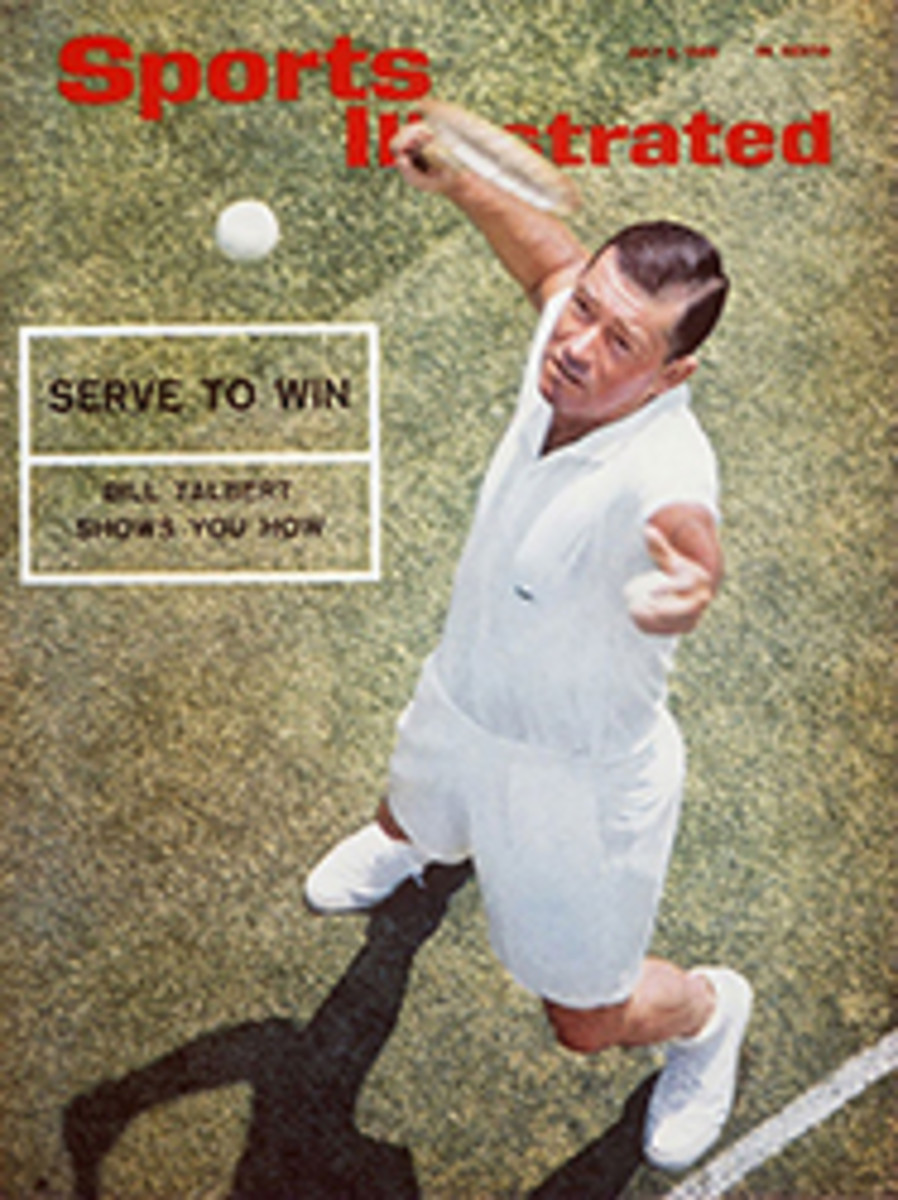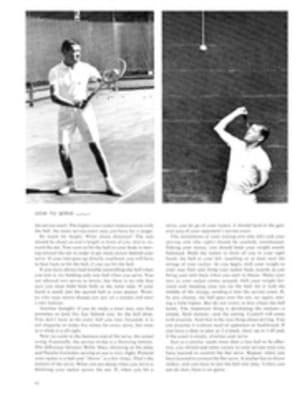
FAST TEEN-AGERS IN GROWN-UP TIME
In San Diego one day last week an 18-year-old boy and a former football linebacker sat down to map out the strategy the boy would have to follow to defeat the most famous of Olympic champions in a mile run. The gall of the pair could be matched only by the futility of their project. But two nights later, in the National AAU track and field championships at San Diego, the man and the boy produced their shocking upset. Pounding out of the last turn like a halfback sweeping end, Jim Ryun, his broad, bony shoulders thrown back, his long, bony knees pumping like oil drills, climaxed a perfectly run race by holding off Peter Snell's furious, final challenge in the most exciting race of an already eventful track season. Ryun's time of 3:55.3 was an American citizen's record and his brilliant race marked another breakthrough by American teen-age distance runners. Only 90 minutes earlier 19-year-old Gerry Lindgren had pushed Olympic Champion Billy Mills to a world record six-mile time of 27:11.6, diving for the tape in such close tandem with Mills that he received equal credit for the record.
In addition to prestige and world records, at stake in San Diego for the first two American finishers in each of 19 events were places on the U.S. track team that will face the Russians in Kiev at the end of July. But young Ryun and his high school coach, J. D. Edmiston, who did far better as a linebacker at the University of Wichita 15 years ago than in the shot, discus and hurdles, were after bigger game.
"We're here for two reasons," Edmiston announced to friends when he and Ryun arrived in town, "and the Russians have nothing to do with them. We're out to beat Snell and we're out to beat the world record. It is going to be a barn-burner."
Three weeks earlier Ryun had finished third to Snell and Jim Grelle in the Compton Invitational (SI, June 14), and had been both vastly elated and tremendously dejected by his performance. He had run outside in the second lane for practically the entire race, adding perhaps 15 or 20 yards to the 1,760 the rest of the field had covered.
"I realized I had run a fast race," Ryun said, "but it was such a dumb one. When Snell made his move at the end I just stood there and watched him."
"But it was significant," chimed in Edmiston. "For the first time Jim realized that he could beat a Peter Snell."
Six nights after Compton, Ryun was back home in Wichita, Kans. grinding out a training session that for sheer speed and volume was far greater than even the hard-working Snell had been able to undergo in New Zealand in preparation for his Olympic 800-and 1,500-meter double victory. Walking for 60 seconds between quarter miles, Ryun had galloped 20 of them at an average speed of 50 seconds per quarter. Despite the exhaustion that must inevitably follow such punishment, he had covered the last one in 56 seconds. Ryun continued his hard training for the next 10 days and then, after a particularly rigorous workout on the Monday before Sunday's race in San Diego, began to ease off. The strategy that Ryun and Edmiston concocted called for the runner to stay near the lead throughout the early part of the race, but in a free and clear position so that he could run close to the pole and not add extra yards. With 330 yards to go, Ryun was to take the lead. Then, as soon as he heard someone spurting up behind him, he would mount a finishing—and hopefully winning—sprint of his own.
The plot seemed wondrously simple, but if there is one thing that seldom goes according to plan it is a mile run. Besides, Snell and the other prerace favorite, Grelle, were in prime condition themselves. Snell had been stricken by an intestinal disorder a week or so earlier but, though he gobbled up three small bottles of Kaopectate on race day, he announced himself fit.
"I feel that I finally have it," he said over a breakfast of cheese omelet and tea, "it" being a combination of 1) good training, 2) confidence and 3) a general feeling of strength. "I also think a little less of Grelle as strong competition, not because he isn't a fine runner, but because I feel sharper now."
But how did he feel about Ryun? Snell held his cup of tea in one hand and stared out across the dining room, obviously trying to decide just how he did feel about the young American.
"Well," he began at last, "one looks at him and thinks, 'How thin he is. He could still use a bit of training.' Besides, I don't like the thought of a teenage distance runner developing so rapidly. I don't care for the idea of a young boy beating strength and experience."
Snell, except for the fact that he has been able to play his favorite game, golf, considerably more often than he does at home in New Zealand, has not enjoyed his final fling at the world quite as much as he had hoped. After his Compton victory Snell lost to Bill Crothers at Toronto. He then moved on to Vancouver, contracted an irritation of the lower colon and finished a dismal 10th behind Grelle in a mile race there.
Grelle, too, had his problems. He lives in Portland, Ore. and works as a salesman for a firm that distributes class rings and yearbook covers. The day he came to San Diego he had bought a new house, closed a contract for yearbook covers and been bumped off his scheduled flight. His main concern, however, was how to run the mile race.
"I don't consider beating Snell at Vancouver a real victory," he said. "He was sick. I know he might have been hard put to beat my time, but Snell is a runner who puts hard. I still want to beat him, but I haven't decided what my goals here will be. Should I try to beat Snell or go for second or third and make sure of the trip to Russia? I'll probably decide during the race when I see how I feel."
By the time Grelle was ready to make up his mind the decision had been denied him. From the very beginning the race promised to be a fast one. Included in the starting field of eight was Josef Odlozil, the Czechoslovakian silver medalist at 1,500 meters in Tokyo. Under the runners was an exceptionally fast track. Made of Grasstex, an asphalt composition material, it had been laid down in Balboa Stadium last September at a cost of $40,000. At the start Cary Weisiger jumped into the lead, but his pace was slow and the time at the half mile was, for this new generation of milers, a sluggish 2:00. With 600 yards left, the boyish-looking Odlozil suddenly sprinted into the lead, but he could hold it only until Ryun, right on plan, charged by him, coming out of the first turn of the last lap. Ryun plunged down the backstretch, with Grelle and Snell thundering along behind him. Going through the last turn Grelle challenged for the lead, but Ryun held him off. Then, when Snell came at him down the final straight, he held the New Zealander off, too. Ryun's time for the final 440 was 54 seconds. Snell had to admit that an 18-year-old, even if he looked as if he needed a bit more training, could still be a formidable miler.
"He ran a very good, tactical race," Snell admitted ungrudgingly later. "He ran wide and I had a very hard time trying to get by him. I just didn't have the zip I needed when I wanted it."
Two events involving the other teenage distance star, Gerry Lindgren, threatened earlier to obscure the mile. They were Lindgren vs. the NCAA and Lindgren vs. Mills. For three weeks prior to the meet the political rug-pulling between the NCAA, which insisted that its member schools boycott the meet, and the AAU over who should control track and field in the U.S. had focused more attention on who would be in the cast than on what kind of show might be put on.
The first important breach of the boycott was made by Lindgren, the tiny freshman distance runner from Washington State, who has made a career of doing the unusual ever since, as a 17-year-old high school senior, he suddenly began to run two-and three-mile indoor races that were astoundingly adult. Now he took on the NCAA by mailing in his entry to compete in the AAU meet.
"It hasn't been easy to stick to this decision," he admitted the week of the race. "My own school said that they'd take away my eligibility and my athletic scholarship A wire from NCAA President Everett Barnes seemed to say that I owed more to my school than my country. Well, that's not the way I look at it."
Even the very ground he trains on conspired against Lindgren. Several days before flying to San Diego he stepped in a hole during a workout and twisted his ankle. It became very sore and swollen and resulted in Lïndgren's temporary withdrawal from the meet. This brought noises from the cynics that the hole was strictly imaginary and had probably been dug by the NCAA's executive director, Walter Byers.
Maybe the skeptics had a point. Lindgren chased Mills around the track as if the Olympic 10,000-meter champion were Byers himself. The two runners, pulling well out in front of the rest of the field, sped along at a world-record pace for 23 laps, then accelerated together through the last quarter mile in a foot-burning 58.6 seconds.
"I felt I had to be lucky to break 28 minutes," Gerry piped in his near-falsetto voice. Mills was less elated. "I was aiming for a record," he said, "and not because I felt that great. The record just isn't that good, Everyone's knocking at the door and all distance records are going to start down, down, down."
That is probably the most important point to emerge from San Diego, where Bob Schul's American citizen's record of 13:10.4 in the three-mile run was all but lost between the longer and shorter races. Schul recently has been beset with a knee injury, a foot injury and a duodenal ulcer. He was a badly beaten last to Snell in the Compton mile and a badly beaten last to Australia's Ron Clarke in the Toronto three-mile. But last week he hardly looked like an invalid Schul alternated in the lead with Neville Scott, the tall New Zealander, and tiny, wiry, balding Ron Larrieu, then sprinted ahead for good with 120 yards to go.
"I feel wonderful," he said after the race. "I felt I could do better than 13:10 if I had to, but with the race in Helsinki coming up so soon I hoped it wouldn't be necessary."
Helsinki is where Schul and Mills were to meet Clarke, who until Sunday held every major world record from three through 10 miles, and recent mile and two-mile record breaker Michael Jazy of France on Wednesday night in a 5,000 meter race. But was Schul worried? No. He felt so good after his win that he could barely stay in bed and was up the following morning at 6 o'clock for a round of golf. That's the way it is when things are going really well.
PHOTO
RICH CLARKSON
Summoning a last, desperate effort from his straining body, Ryun holds off New Zealander Snell to win the mile in American-record time.

